After the first week of action there’s normally a lot of extrapolating going on. The problem with much of this is it pays little attention to the opponent and how well or poorly they played. It allows people to think/say things like: Andy Dalton will play as well as he did against the Raiders all year. Oh, wait…
But all joking aside, many things will certainly look different after Week 2 than they did after Week 1 – but there are some trends, ones that have been in the works since last season, are particularly concerning.
Like this one: The Seahawks have a bad offensive line.
The question is whether that issue – and it’s a significant one – is enough to derail Seattle’s Super Bowl hopes. Consider these points:
–Last year, no quarterback was pressured on a higher percentage of plays than the Seahawks’ Russell Wilson, at 46 percent (the NFL average is 34 percent). And still the Seahawks came within one dodgy play-call of a second straight Super Bowl win.
–Last year, they gained their superstar RB Marshawn Lynch (the man unfairly robbed of the league MVP by people far less biased than me) a lackluster 1.8 yards before contact (14th in the league). And still the Seahawks came within one dodgy play-call of a second straight Super Bowl win.
–In Week 1, against the Rams' superb defensive line, Wilson was pressured on a roughly equitable 43 percent of plays … and nearly won the game.
Overcoming a bad offensive line can be done, in other words, and if any team can do it, Seattle can. Here’s why.
Quick, name the last team with a dominating offensive line to win a Super Bowl? I would argue we haven’t had one in the PFF era (since 2007). How about Super Bowl contestants? Probably the 2012 49ers, but that’s it.
Supplementary question: How many of the winners in that period have had even an above-average line? I’d say maybe three; the Giants in 2007, the Saints in 2009 and the Ravens in 2013.
You can argue some of that (David Diehl was a huge negative for New York in 2007), and maybe push for a few more (the Packers in 2010 had some very good individual performances along with a few awful ones), but regardless, it’s difficult to say there is a trend towards a team needing a great O-line to win a championship.
In fact, some of the more recent winners have overcome huge deficiencies. Last year we ranked the Patriots 31st in pass blocking, and no team gave up as much inside pressure (as a percentage of overall pressure) as New England. Inside pressure is normally far more difficult to deal with because it comes more quickly and doesn’t allow the quarterback to step up.
So, Seattle does have recent history on its side with this one, but make no mistake: This is a bad situation. The Seahawks traded Max Unger, their best offensive lineman, to the Saints for TE Jimmy Graham, and then made little effort in the draft or free agency to address their problems. As a result, the starting Seattle offensive line looks like this:
That’s every player at or below replacement-level in terms of our PFF ratings, and, as might be expected, they did not have an easy time versus the Rams. We are expecting those struggles to continue, and while it doesn’t make a Super Bowl run impossible, it certainly makes a third straight NFC title much more difficult.



 © 2024 PFF - all rights reserved.
© 2024 PFF - all rights reserved.